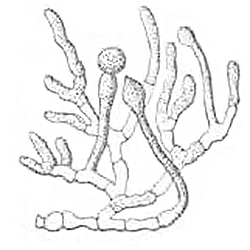|
Zygomycosis
Zygomycosis is the broadest term to refer to infections caused by ''bread mold fungi'' of the zygomycota phylum. However, because zygomycota has been identified as polyphyletic, and is not included in modern fungal classification systems, the diseases that zygomycosis can refer to are better called by their specific names: mucormycosis (after Mucorales), phycomycosis (after Phycomycetes) and basidiobolomycosis (after Basidiobolus). These rare yet serious and potentially life-threatening fungal infections usually affect the face or oropharyngeal (nose and mouth) cavity. Zygomycosis type infections are most often caused by common fungi found in soil and decaying vegetation. While most individuals are exposed to the fungi on a regular basis, those with immune disorders (immunocompromised) are more prone to fungal infection. These types of infections are also common after natural disasters, such as tornadoes or earthquakes, where people have open wounds that have become filled with ... [...More Info...] [...Related Items...] OR: [Wikipedia] [Google] [Baidu] |
Mucormycosis
Mucormycosis, also known as black fungus, is a serious fungal infection that comes under fulminant fungal sinusitis, usually in people who are immunocompromised. It is curable only when diagnosed early. Symptoms depend on where in the body the infection occurs. It most commonly infects the nose, sinuses, eye, and brain resulting in a runny nose, one-sided facial swelling and pain, headache, fever, blurred vision, bulging or displacement of the eye (proptosis), and tissue death. Other forms of disease may infect the lungs, stomach and intestines, and skin. It is spread by spores of molds of the order Mucorales, most often through inhalation, contaminated food, or contamination of open wounds. These fungi are common in soils, decomposing organic matter (such as rotting fruit and vegetables), and animal manure, but usually do not affect people. It is not transmitted between people. Risk factors include diabetes with persistently high blood sugar levels or diabetic ketoacidos ... [...More Info...] [...Related Items...] OR: [Wikipedia] [Google] [Baidu] |
Phycomycosis
Phycomycosis is an uncommon condition of the gastrointestinal tract and skin most commonly found in dogs and horses. The condition is caused by a variety of molds and fungi, and individual forms include pythiosis, zygomycosis, and lagenidiosis. Pythiosis is the most common type and is caused by '' Pythium'', a type of water mould. Zygomycosis can also be caused by two types of zygomycetes, '' Entomophthorales'' (such as ''Basidiobolus'' and '' Conidiobolus'') and '' Mucorales'' (such as '' Mucor'', '' Mortierella'', '' Absidia'', '' Rhizopus'', '' Rhizomucor'', and '' Saksenaea''). The latter type of zygomycosis is also referred to as mucormycosis. Lagenidiosis is caused by a '' Lagenidium'' species, which like ''Pythium'' is a water mould. Since both pythiosis and lagenidiosis are caused by organisms from the class Oomycetes, they are sometimes collectively referred to as oomycosis. Pythiosis Pythiosis is caused by '' Pythium insidiosum'' and occurs most commonly in ... [...More Info...] [...Related Items...] OR: [Wikipedia] [Google] [Baidu] |
Zygomycosis
Zygomycosis is the broadest term to refer to infections caused by ''bread mold fungi'' of the zygomycota phylum. However, because zygomycota has been identified as polyphyletic, and is not included in modern fungal classification systems, the diseases that zygomycosis can refer to are better called by their specific names: mucormycosis (after Mucorales), phycomycosis (after Phycomycetes) and basidiobolomycosis (after Basidiobolus). These rare yet serious and potentially life-threatening fungal infections usually affect the face or oropharyngeal (nose and mouth) cavity. Zygomycosis type infections are most often caused by common fungi found in soil and decaying vegetation. While most individuals are exposed to the fungi on a regular basis, those with immune disorders (immunocompromised) are more prone to fungal infection. These types of infections are also common after natural disasters, such as tornadoes or earthquakes, where people have open wounds that have become filled with ... [...More Info...] [...Related Items...] OR: [Wikipedia] [Google] [Baidu] |
Basidiobolus
''Basidiobolus ranarum'' is a filamentous fungus with worldwide distribution. The fungus was first isolated by Eidam in 1886. It can saprophytically live in the intestines of mainly cold-blooded vertebrates and on decaying fruits and soil. The fungus prefers glucose as a carbon source and grows rapidly at room temperature. ''Basidiobolus ranarum'' is also known as a cause of subcutaneous zygomycosis, usually causing granulomatous infections on a host's limbs. Infections are generally geographically limited to tropical and subtropical regions such as East and West Africa. Subcutaneous zygomycosis caused by ''B. ranarum'' is a rare disease and predominantly affects children and males. Common subcutaneous zygomycosis shows characteristic features and is relatively easy to be diagnosed; while, certain rare cases might show non-specific clinical features that might pose a difficulty on its identification. Although disease caused by this fungus is known to resolve spontaneously on its o ... [...More Info...] [...Related Items...] OR: [Wikipedia] [Google] [Baidu] |
Apophysomyces Elegans
''Apophysomyces'' is a genus of filamentous fungi that are commonly found in soil and decaying vegetation. Species normally grow in tropical to subtropical regions. The genus ''Apophysomyces'' historically was monospecific, containing only the type species '' Apophysomyces elegans''. In 2010, three new species were described: ''variabilis'', ''trapeziformis'', and ''ossiformis''. Characteristics Among the other members of zygomycetes, ''Apophysomyces elegans'' mostly resembles those from genus ''Absidia''. However, its bell-shaped (although not conical) apophyses (outgrowth), the existence of its foot-cell like hyphal segment, rhizoids produced opposite to the sporangiophores upon cultivation on plain agar, the darker and thicker subapical segment, and inability to sporulate on routine culture media help in distinguishing ''Apophysomyces elegans''.Davise H. Larone, "Medically Important Fungi - A Guide to Identification", 3rd ed. (1995). (ASM Press, Washington, D.C.). (ISBN is ... [...More Info...] [...Related Items...] OR: [Wikipedia] [Google] [Baidu] |
Mucor
''Mucor'' is a microbial genus of approximately 40 species of molds in the family Mucoraceae. Species are commonly found in soil, digestive systems, plant surfaces, some cheeses like Tomme de Savoie, rotten vegetable matter and iron oxide residue in the biosorption process. Description Colonies of this fungal genus are typically white to beige or grey and fast-growing. Colonies on culture medium may grow to several centimeters in height. Older colonies become grey to brown in color due to the development of spores. The species 'Mucor' belongs to the microbial kingdom: Fungi. ''Mucor'' spores or sporangiospores can be simple or branched and form apical, globular sporangia that are supported and elevated by a column-shaped columella. ''Mucor'' species can be differentiated from molds of the genera '' Absidia'', '' Rhizomucor'', and '' Rhizopus'' by the shape and insertion of the columella, and the lack of stolons and rhizoids. Some ''Mucor'' species produce chlamydospo ... [...More Info...] [...Related Items...] OR: [Wikipedia] [Google] [Baidu] |
Mucoraceae
The Mucoraceae are a family of fungi of the order Mucorales, characterized by having the thallus not segmented or ramified. Pathogenic genera include '' Absidia'', '' Apophysomyces'', ''Mucor'', '' Rhizomucor'', and ''Rhizopus''. According to a 2008 estimate, the family contains 25 genera and 129 species. Genera The family consists of the following genera: * '' Actinomucor'' * '' Apophysomyces'' * '' Benjaminiella'' * '' Chaetocladium'' * '' Circinella'' * ''Cokeromyces'' * '' Dicranophora'' * '' Ellisomyces'' * '' Helicostylum'' * '' Hyphomucor'' * '' Kirkomyces'' * ''Mucor'' * '' Parasitella'' * '' Pilaira'' * '' Pilophora'' * '' Pirella'' * '' Rhizomucor'' * '' Rhizopodopsis'' * ''Rhizopus'' * '' Sporodiniella'' * ''Syzygites ''Syzygites'' is a monotypic genus in Zygomycota. The sole described species is ''Syzygites megalocarpus'', which was the first fungus for which sex was reported and the main homothallic representative in the research that allowed for the cla ... ... [...More Info...] [...Related Items...] OR: [Wikipedia] [Google] [Baidu] |
Absidia
''Absidia'' is a genus of zygote fungi in the family Cunninghamellaceae. ''Absidia'' species are ubiquitous in most environments where they are often associated with warm decaying plant matter, such as compost heaps. Some species in the genus can cause phycomycosis. Taxonomy The genus was first described in 1878 by Philippe Édouard Léon Van Tieghem. Species The genus includes the following species: * ''Absidia aegyptiaca'' * '' Absidia anomala'' * ''Absidia atrospora'' * '' Absidia caerulea'' * ''Absidia californica'' * '' Absidia clavata'' * '' Absidia cuneospora'' * ''Absidia cylindrospora'' * '' Absidia dubia'' * '' Absidia fassatiae'' * '' Absidia glauca'' * '' Absidia griseola'' * '' Absidia heterospora'' * '' Absidia idahoensis'' * '' Absidia inflata'' * '' Absidia macrospora'' * '' Absidia narayanai'' * '' Absidia pseudocylindrospora'' * '' Absidia psychrophilia'' * '' Absidia reflexa'' * '' Absidia repens'' * ''Absidia spinosa'' * ''Absidia tuneta'' * '' Absidia us ... [...More Info...] [...Related Items...] OR: [Wikipedia] [Google] [Baidu] |
Absidia Corymbifera
''Lichtheimia corymbifera'' is a thermophilic fungus in the phylum Zygomycota. It normally lives as a saprotrophic mold, but can also be an opportunistic pathogen known to cause pulmonary, CNS, rhinocerebral, or cutaneous infections in animals and humans with impaired immunity. Appearance ''Lichtheimia corymbifera'' was originally described as ''Mucor corymbifer'' in 1884 by Lichtheim from clinical isolations in Wrocław, Poland. At the time of the description, the species epithet, "corymbifer" was attributed to Cohn. In 1903, the fungus was transferred to the mucoralean genus ''Lichtheimia'' (honoring Lichtheim) by Jules Vuillemin as ''L. corymbifera''. In 1912 the species was again transferred by Saccardo and Trotter to the genus ''Absidia'' as ''A. corymbifera'' where it remained for most of the 20th century. Alastruey-Izquierdo and colleagues in 1991 transferred the species to the genus ''Mycocladus'', described originally by Beauverie in 1900. The type of ''Mycocladus'' ha ... [...More Info...] [...Related Items...] OR: [Wikipedia] [Google] [Baidu] |
Fungus
A fungus (plural, : fungi or funguses) is any member of the group of Eukaryote, eukaryotic organisms that includes microorganisms such as yeasts and Mold (fungus), molds, as well as the more familiar mushrooms. These organisms are classified as a Kingdom (biology), kingdom, separately from the other eukaryotic kingdoms, which by one traditional classification include Plantae, Animalia, Protozoa, and Chromista. A characteristic that places fungi in a different kingdom from plants, bacteria, and some protists is chitin in their cell walls. Fungi, like animals, are heterotrophs; they acquire their food by absorbing dissolved molecules, typically by secreting digestive enzymes into their environment. Fungi do not photosynthesize. Growth is their means of motility, mobility, except for spores (a few of which are flagellated), which may travel through the air or water. Fungi are the principal decomposers in ecological systems. These and other differences place fungi in a single gro ... [...More Info...] [...Related Items...] OR: [Wikipedia] [Google] [Baidu] |


